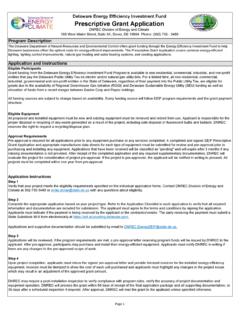Transcription of PROGRESS REPORT APRIL 2018 NYC CARBON …
1 1 | NYC CARBON CHALLENGE PROGRESS REPORT APRIL 2018 The City of New YorkMayor Bill de BlasioMayor s Office of SustainabilityNYC CARBON CHALLENGEPROGRESS REPORT APRIL 20182 | NYC CARBON CHALLENGE PROGRESS REPORT APRIL 2018 Executive SummaryProgram SummaryEarly AchieversRetailColleges and Universities Hospitals Commercial Owners and Tenants Multifamily HotelsConclusionEnd Notes 3591013192537414547 Table of ContentsNYC CARBON CHALLENGEPROGRESS REPORT APRIL 20183 | NYC CARBON CHALLENGE PROGRESS REPORT APRIL 2018 Executive SummaryProgram SummaryEarly AchieversRetailColleges and Universities Hospitals Commercial Owners and Tenants Multifamily HotelsConclusionEnd Notes Global climate change is one of the most significant challenges we face today. Across the globe, greenhouse gas (GHG) emissions continue to increase, causing a rise in average global temperature and changes to climate patterns.
2 New York City is experiencing the impacts of climate change firsthand from rising sea levels, increasing temperatures and heat waves, and more frequent and intense storms. The damage caused by and Hurricane Sandy in 2012 provided tragic evidence of these Earth Day 2015, New York City Mayor Bill de Blasio announced One New York: The Plan for a Strong and Just City (OneNYC), a groundbreaking effort to address New York City s long-term challenges. As part of OneNYC, New York City committed to reduce GHG emissions 80 percent by 2050 from 2005 levels (80 x 50), with an interim target to reduce emissions 40 percent by 2030 (40 x 30). When the United States announced it would pull out of the Paris Climate Agreement in June 2017, New York City pledged to adhere to the goals of the Agreement and accelerate its commitment to 80 x 50 by front-loading the most dramatic reductions in the coming decade.
3 New York has been joined by more than 400 other municipalities across the country in this collective climate action problem cannot be solved without the help of all New Yorkers. To make PROGRESS toward 80 x 50, New York City has relied on the action and leadership of its private and institutional sector leaders. The City first launched the NYC CARBON Challenge (Challenge) in 2007 to partner with the city s leading colleges and universities to achieve significant GHG emissions reductions in their buildings. Participants have pledged to voluntarily reduce their building-based GHG emissions by 30 percent or more over the course of ten years. Since the initial launch, over 100 participants have accepted the Challenge, including the City s largest colleges and universities, hospitals, commercial owners and tenants, residential property management firms, and hotels.
4 In total, current participants account for over 510 million square feet of real estate, or more than nine percent of citywide building square footage . Since the launch of the Challenge, participants have significantly cut their energy use and GHG emissions, revealing effective strategies and providing insight on how to use voluntary action to meet policy goals. The Challenge has also fostered collective action by creating a platform to share ideas and engaging new communities in the effort to address climate change. 2017 marked the anniversary of the initial ten-year Challenge for colleges and universities, but not the end of participants efforts. Seventeen New York City colleges and universities have deepened their commitments under the Challenge, pledging to reduce their GHG emissions by 40 percent or 50 percent.
5 Their proven strategies can now be replicated across colleges and universities across the state and the rest of the country even as these New York City leaders continue to push forward with their bold commitments to climate action and innovative new strategies to reduce GHG Summary4 | NYC CARBON CHALLENGE PROGRESS REPORT APRIL 2018 OUTCOMES AND PROJECTED IMPACTSA ltogether, participants have cut their annual GHG emissions by 580,000 metric tons of CARBON dioxide equivalent (tCO2e) the equivalent of removing 125,000 cars from the roads and are collectively saving an estimated $190 million annually in lower energy costs. To achieve these reductions, Challenge participants have spent an estimated $ billion on energy efficiency and capital upgrades to their buildings, creating an estimated 1,600 local construction-related jobs and improving local air quality by reducing air particulate matter ( ) by 58 metric tons.
6 LOOKING FORWARDThe success of the Challenge is a powerful demonstration that New York City s largest private and institutional sector organizations can work with the City toward the common goals of fighting climate change and creating a healthier and more sustainable place to live for all New Yorkers. Challenge participants have demonstrated that deep reductions in GHG emissions are achievable while also realizing other benefits such as improved local air quality, cost savings, and increased tenant comfort. Looking forward, the diverse set of ABSOLUTE GHG REDUCTION TO DATEAVERAGE GHG PERCENTAGE REDUCTION BY SECTORELECTRICITY5 MtCO2e4 MtCO2e3 MtCO2e2 MtCO2e1 MtCO2e-582,740 tCO2eDISTRICT FUEL FUEL OILNATURAL -1 7. 5 % Challenge participants will continue to demonstrate that individual organizations can motivate each other to cut their GHG emissions and contribute toward citywide emissions reduction goals.
7 All university and hospital participants have now extended their commitments to either a 50 percent reduction by 2025 or a 40 percent reduction by 2030. Across all sectors, Challenge participants have achieved significant reductions so far, but there is still more PROGRESS to be made. The Mayor s Office will continue to work with participants to achieve and exceed their goals by piloting innovative technologies and replicating best practice retrofit strategies to deepen GHG emissions reductions. With each new participant that crosses the finish line, New York City will become a stronger and more sustainable city. With the enduring success of the Challenge, participants continue to demonstrate that deep reductions in GHG emissions in buildings are YEAR5102,300580,000$ ,600 MILLION square FEETOF REAL ESTATE9% OF CITY-WIDE BUILT square FOOTAGEHOSPITALIZATIONS AVERTED BY58 MILLION TONS REDUCEDMILLION MMBTUDIRECT JOBSMILLIONREDUCEDCREATEDTONS OF CO2e REDUCEDIN ENERGY COST SAVINGS TO DATE5 | NYC CARBON CHALLENGE PROGRESS REPORT APRIL 2018 Program SummarySIZECARBONENERGYSAVINGSHEALTHJOBS EQUIVALENT TO TAKING 125,000 CARS OFF THE ROADEQUIVALENT TO TAKING 170,000 HOMES OFF THE GRID6 | NYC CARBON CHALLENGE PROGRESS REPORT APRIL 2018 NEW YORK CITY S CLIMATE STRATEGYTo address the challenges and mitigate the threats of climate change.
8 New York City must adapt to a changing climate and take bold action to reduce the harmful GHG emissions that contribute to a changing climate. New York City has joined the world s leading cities in doing our part to reduce our contributions to global GHG emissions, by committing to 80 x 50, and aligning ourselves with the Paris Climate Agreement. Achieving this goal requires significant reductions in GHG emissions produced by the city s energy supply, buildings, transportation, and solid waste. We now know that to achieve 80 x 50 the City must accelerate efforts to: Make all buildings significantly more energy efficient Replace many fossil fuel-based heating and hot water systems in buildings with renewable or high-efficiency electric systems Scale up on-site installations of renewable energy sources across buildings and City-owned properties Transition towards a renewables-based electric grid Reduce the number of miles driven and remaining vehicles with zero-emissions vehicles Achieve the goal of sending Zero Waste to landfillsIn New York City, close to 70 percent of citywide GHG emissions can be attributed to the energy used to heat, power, and cool buildings, and more than 90 percent of the buildings that are here today will still be here in 2050.
9 Therefore, improving the energy efficiency of New York City s existing building stock presents the most important opportunity to reduce citywide GHG emissions in the long term. The City is committed to pioneering and leading the way through energy efficiency and conservation measures in its City-owned buildings while also working with private and institutional leaders to drive building energy efficiency to achieve our 80 x 50 COLLEGE AND UNIVERSITY CHALLENGELAUNCHED HOSPITAL CHALLENGELAUNCHED COMMERCIAL CHALLENGE AND MULTIFAMILY CHALLENGE12 PARTICIPANTS COMMIT TO 50% REDUCTION GOAL, LAUNCHED HOTEL CHALLENGECOMMERCIAL CHALLENGEEXPANDED TO INCLUDE 10 COMMERCIAL OWNERS AND 12 NEW COMMERCIAL TENANTS LAUNCH OF RETAIL CHALLENGE,UNIVERSITIES AND HOSPITALS EXTEND COMMITMENTS7 | NYC CARBON CHALLENGE PROGRESS REPORT APRIL 2018 THE NYC CARBON CHALLENGEThe City launched the Challenge in 2007 to partner with leading institutions and private sector companies to achieve significant GHG reductions in their buildings.
10 The program is a voluntary leadership program that challenges participants to reduce their GHG emissions by 30 percent or more in ten years. The Challenge works by inspiring a high-level commitment within organizations, creating a platform for the exchange of information and ideas, and providing simple tools to track PROGRESS along the way. The Challenge was designed to identify and overcome market barriers to the sector s investment in energy efficiency and support leading building owners and managers who have committed to ambitious GHG emissions reduction targets. The Challenge has inspired the organizational commitment to reduce emissions across partner institutions, reduced the learning curve for energy management staff, and engaged new communities in the effort to tackle climate change. As Challenge participants explore innovative ideas and opportunities to meet their goals, they have revealed effective strategies that can be scaled up across New York City and beyond.












